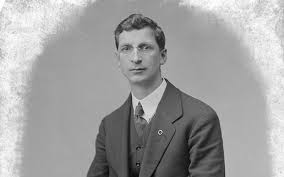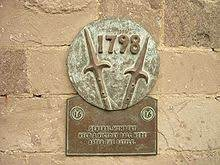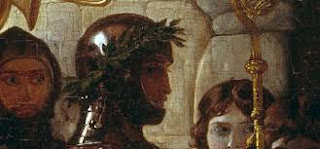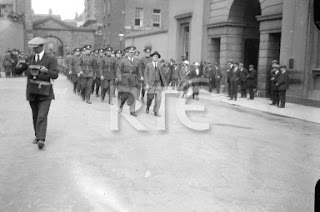14 August 1598 O.S./24 August 1598 N.S.- the Battle of the Yellow Ford (Cath Bhéal-an-Átha-Buí) was fought on this day. It was fought between the forces of Aodh [Hugh] O’Neill the Earl of Tyrone and those of Queen Elizabeth I of England under the direct command of Marshal Bagenal. The cause of the battle was the attempt by the English to relieve their garrison at the Portmore fort situated adjacent to the Black water river. This tiny outpost of about 150 men was nothing more really than an earthen structure in need of constant repair and revictualling. Situated some two miles north of the ancient settlement of Armagh it was meant to act as a toehold into Tyrone and thus a gateway into the heart of Ulster. However it was in fact a thorn in the side of the English who found it difficult to maintain but could not afford the loss of prestige of abandoning it to O’Neill who for some years had been in revolt against the English Queen.
CSP IRELAND
https://www.british-history.ac.uk/cal-state-papers/ireland/1598-9/pp217-254
In the year 1598 Ireland was a country divided in its allegiances. The most powerful man in the North, Aodh O’Neill & his allies were in revolt against the Crown under its English monarch Queen Elizabeth I. The Gaelic Catholic chieftains had been nominally loyal to her but resented the creeping English encroachment on Gaelic lands and on their way of life. O’Neill saw what was coming and rather than await events he had revolted, at first by proxy and then openly. But many others stood on the fence until things became clearer. Most of the Catholic ‘Old English’ who were descended from the original colonists of the 12th century were also still loyal to her albeit reluctantly, but they feared for their safety at the hands of the Gaelic Irish and gave lukewarm support to the war effort.. There was also a tiny but growing number of ‘New English’ who were protestant and very loyal but were fearful of their tenuous grasp on their new holdings in Ireland. Those in positions of power & who were Catholic, both English or Gaelic, were reluctant to accept her rule as currently dictated but bided their time to see what way the war then raging between the warring parties would fall out.
The conflict had intensified since 1593 and broken out into open warfare the following year. The most intense fighting & manoeuvring was in the province of Ulster where the Earl of Tyrone - Aodh O’Neill - led the most serious resistance to English Rule. His defiance was quite successful and his shrewd and determined stand was being carefully watched by the leading Catholics of Ireland - who at least retained a nominal allegiance to the Crown in the absence of any viable alternative. For they were caught on the horns of a dilemma. To do nothing was to await the ever advancing encroachment of English Rule and with that the loss of their lands and the enforcement of an alien Religion upon them and their people. On the other hand to rise in open revolt was a huge risk as failure in such an enterprise would mean not just loss of territory but loss of everything. The end result was probably either exile, a violent death in battle or in the back or their heads on the walls of Dublin Castle.
By the summer of 1598 the situation here had gained attention abroad, it was not just a drain on England’s manpower and thus a further complication in her conduct of international affairs but also sucked on the Crown’s finances that had to be met by the Exchequer. As in many wars a place that is of insignificance in and of itself became to assume an importance out of all proportion to its real value. This place was the English held fort of the Blackwater on the banks of the river called Portmore. This tiny outpost of about 150 men was nothing more really than an earthen structure in need of constant repair and revictualling. Situated some four miles north west of the ancient settlement of Armagh it was meant to act as a toehold into Tyrone and thus a gateway into the heart of Ulster. However it was in fact a thorn in the side of the English who found it difficult to maintain but could not afford the loss of prestige of abandoning it to Aodh O’Neill and thus increasing his prestige at the expense of their own.
So the English had a choice, they could abandon it and thus risk ignominy, or they could attempt to relieve the garrison and resupply it with fresh troops and provisions. Opinion was divided within Dublin Castle with the more conservative pressing for withdrawal and the more bellicose for an Expedition to put O’Neill in his place and retain the fort as a springboard to launch a full scale attack on O’Neill’s heartland of Tyrone. Most commanders were reluctant to undertake such a risky enterprise but what tipped the scales was the stepping forward of one Sir Henry Bagenal, Marshal of Ireland. He had a personal grudge against O’Neill who had bested him on campaign and more importantly had eloped with his sister Mabel and married her without his consent. He was determined to take his revenge on a man who had humiliated him both in bed and battle.
The New Fort, of which we have before written an account, was defended during the time of peace and war by the Queen's people; but when the English and Irish did not make peace as had been expected in the beginning of summer, O'Neill laid siege to the fort, so that the warders were in want of provisions in the last month of summer.
Annals of the Four Masters [AFM]
Once a course of action was decided upon a determined effort was made to put together a substantial force to undertake the expedition. With some some difficulty about 4,000 foot & 300 horse were gathered together at Ardee Co Louth on 7 August and began to march north via Newry. They reached Armagh on the 13th and encamped.
Sir Henry Bagenall, the Marshal, is now to draw into Ulster with part of the army (consisting of 3,500 men by poll, and about 300 horse), to revictual the Blackwater; and the Lord Lieutenant, with another part of the army, is to attend the prosecution in Leinster. The nobility of the English Pale, with the strength of the country, have been appointed to remain in defence upon the borders till the army return out of Ulster. The day for the rendezvous of the latter is the 7th instant, at Ardee, whence they are to march to Newry, and so to the Blackwater.
Calendar of State Papers [CSP] IRELAND 1598
In the years since the conflict began O’Neill had built up a formidable fighting force under his command. They were unlike the warriors of old who just fought with sword, spear & darts but he now had organised bodies of fighting men who were reasonably armed with pike and shot. It was the men armed thus with long range weapons who proved crucial on the day of battle.
No less than an opponent than Lord Mountjoy, Tyrone’s eventual nemesis noted that ‘so far from being a naked people , as before times, were generally better armed than we....and even exceeded us in that discipline which was fittest for the advantage of the natural strenght of the country, for that they, being very many, and expert shot, and excelling in footmanship all other nations, did by that means make better use of those strenghts [that is their own wild terrain] both for offense and defense, than could have been made of any squadrons of pikes or artifical fortifications of towns’
The Yellow Ford, Irish Battles - G.A. Hayes McCoy
O’Neill of course knew that they were coming. His scouts, spies and informants kept a constant flow of information coming into him so he would not be caught unawares by any sudden moves upon him. This of course was a two way affair with the English also utilising the same methods to ascertain what was afoot. But given the more static nature of the Crown Forces in castles, keeps and towns it was easier for the Irish to spy their comings and goings than vice versa as the Irish kept to their lakes, bogs, woodlands and remote places to mask their locations & intentions. By the time Bagenal’s force arrived in Armagh he was in position to meet and repulse any attempt to relieve the beleaguered garrison.
When O'Neill had received intelligence that this great army was approaching him, he sent his messengers to O'Donnell, requesting of him to come to his assistance against this overwhelming force of foreigners who were coming to his country. O'Donnell proceeded immediately, with all his warriors, both infantry and cavalry, and a strong body of forces from Connaught, to assist his ally against those who were marching upon him. The Irish of all the province of Ulster also joined the same army, so that they were all prepared to meet the English before they arrived at Armagh. They then dug deep trenches against the English in the common road, by which they thought they the English would come to them.
AFM
The Marshal broke camp early on the 14 August and began to march north hoping to skirt O’Neill’s formidable defenses by avoiding the main route to the Blackwater fort. In this he was to be stymied as the Irish had extended their defenses over a stretch of ground approximately a mile or so whose primary obstacle was a huge waterlogged ditch topped with thorny hedges. The whole area was wet and boggy with only limited patches that were dry and suitable to cross in any cohesive way. The areas where any woodland existed had been ‘plashed’ that is the undergrowth had been interlaced to form impediments to passage.
Bagenal’s force was divided into three columns - the Van, the Battle & Rear with the Marshal up front with the Van. They made slow progress and got through to the ‘Yellow Ford’ [Beal-an-atha-bhuidhe] whose location is now unknown but was probably a pathway through the watery bogs. The Van made it up to the ditch itself and broke into the ground beyond it. They were almost there opposite the fort whose haggard garrison could see them from afar. So it looked like that O’Neill was not going to seriously contend the issue other than one of severe harassment of the relieving force - a traditional enough tactic.
It was at this stage that it all began to fall apart for the Marshal. His columns had become dangerously extended and his Van came under severe and sustained attack. The Battle in turn learned that the Rear was also under attack. Wingfield who led the Battle called upon Bagenal to return to the centre to sort it all out. This he did and satisfied that he had done enough he went to go forward again and try to re-stablish contact with Percy who was at the head of the lead regiment. But Percy’s force had collapsed by this stage as the Irish smelt blood with him being so isolated alone on their side of the trench and pressed home their attacks. Before the Marshal could even make it back as far as the trench he had to raise his visor to get a better view of what has actually going on- and got a bullet in his head for his troubles! To make matters worse for his men their saker cannon got stuck in a bog and had to be abandoned. Then an ammunition wagon blew up which totally spooked the newer recruits and they ran for it.
the Marshal of Newry, was slain; and as an army, deprived of its leader and adviser, does not usually maintain the battle-field, the General's people were finally routed, by dint of conflict and fighting, across the earthen pits, and broad, deep trenches, over which they had previously passed. They were being slaughtered, mangled, mutilated, and cut to pieces by those who pursued them bravely and vigorously.
AFM
The invading force began to disintegrate at this stage and men started to flee for their lives with all cohesion gone. The raw recruits in particular new from England could not take it and with them gone any veterans left could only do a slow retreat and attempt to retain some level of order in their ranks as they made for the relative safety of Armagh.
By nightfall it was apparent that O’Neill had won a great Victory, perhaps in relative terms the greatest any Gaelic leader had ever won over the English since they came here. The remnants of the invading column made it back under constant attack to the ruins of Armagh Cathedral, approximately 1,500 men out of 4,000, who huddled there that night to await the dawn. O’Neill had shattered them with maybe losing circa 800 men out of a force perhaps a shade below 5,000 strong, a not inconsiderable loss but worth it for what was achieved.
Captain Montague's report of the accident at Armagh; dated 16 August, 1598."
"On Monday, the 14th of August, the army marched from Armagh (leaving there all our victuals and some munition), for the Blackwater, by computation, 3,500 foot and 300 horse. Their form was in six regiments...By the Captains' estimation we had killed and run away to the enemy, not less than 1,800 foot, some ten horsemen, and thirty horses. The enemy lost, as we heard by some of theirs that we took, seven or eight hundred. There remains of ours about 1,500 in the Church of Armagh."
CSP Ireland 1598
they finally agreed to give them liberty to pass out of the places in which they were, on condition, however, that they should not carry out of the fort meat or drink, armour, arms, or ordnance, powder or lead or, in fine, any thing, excepting only the captain's trunk and arms, which he was at liberty to take with him....They were all then escorted from Armagh to Newry, and from thence to the English territory. After their departure from Tyrone, O'Neill gave orders to certain persons to reckon and bury the gentlemen and common people slain. After they had been reckoned, there were found to be two thousand five hundred slain, among whom was the General, with eighteen captains, and a great number of gentlemen whose names are not given.
AFM
The remains of the force who had set out so confidently that morning were surrounded by the Irish and that night what was left of the horse broke out and made it back to Newry, within a couple of days the news was in Dublin. The Lords Justices there immediately dispatched a letter of plea to the Earl pointing out that a further massacre could only provoke the Queen further against him. The Earl was smooth operator to his fingertips and knew a negotiated peace was his Holy Grail in this conflict. He consented to spare the lives of those soldiers of the Queen who were cut off from succour and let them go stripped of their arms and accoutrements to return to whence they came - and the surrender of the Blackwater Fort to boot.
The Queen's people were dispirited and depressed, and the Irish joyous and exulting, after this conflict. This battle of Athbuidhe was fought on the 10th day of August. The chiefs of Ulster returned to their respective homes in joyous triumph and exultation, although they had lost many men.
AFM
News of this great victory soon spread across Ireland and the effect was to galvanise many who had doubts about rising out to discard them and cast their lot in with O’Neill. The English now faced the greatest threat to their hold on Ireland in over 400 years - only time would tell how that would turn out.


































